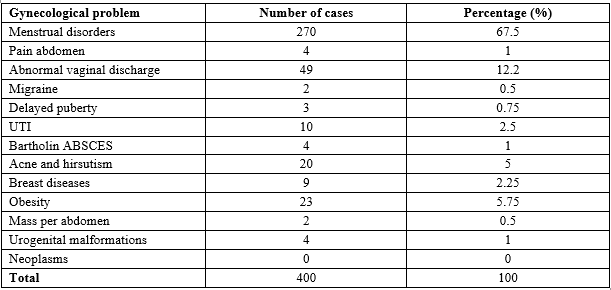Prevalence of various gynecological problems in adolescent girls 10-19 years of age attending outpatient Department at tertiary care institute of Bhuj, Kutch, Gujarat, India
Abstract
Background and Aim: Various adolescent Gynecological problems are menstrual disorders like abnormal uterine bleeding, primary amenorrhoea, PCOD, puberty menorrhagia leading to severe anemia, sexual abuse, pregnancy-related problems, adnexal masses, endocrinopathies, etc. The present study was done with an aim to study the prevalence, etiological factors of various gynecological problems in adolescent girls 10-19 years of age, attending to the outpatient Department of Gynecology, Gujarat Adani Institute of Medical Science, Bhuj, Kutch, Gujarat.
Material and Methods: Present observational study was conducted on 400 Adolescent girls (10-19 years) presenting with gynecological complaints presenting at the Department of Gynecology, Gujarat Adani Institute of Medical Science, Bhuj, Kutch, Gujarat for the period of one year. In addition to the general examination, physical examination including height and weight, secondary sexual characters, presence of any congenital anomalies were recorded and data regarding sociodemographic factors collected in a predesigned questionnaire/proforma.
Results: Dysmenorrhea was the most prevalent complaint in the early adolescent group. Menstrual disorders were the most common presentation to the adolescent gynecological outpatient department followed by abnormal vaginal discharge. Among menstrual disorders dysmenorrhea was the most common 42.5%, irregular menses 24.07%, and heavy menstrual bleeding 14.8%.
Conclusion: Menstrual problems are the commonest reason for gynecological OPD consultation among adolescent girls. Evaluation of bleeding problems in adolescents is justified, before considering them as the normal physiological transition. Though adolescents constitute only about 5% of all patients attending the gynaec outpatient department, adolescent gynecological problems are unique and specific regarding presentation, diagnosis, and management of their problems is important for their future reproductive health.
Downloads
References
Hanson M, Gluckman P. Evolution: development and timing of puberty. Trends Endocrinol Metab. 2006;17(1):7–12. doi: https://doi.org/10.1016/j.tem.2005.11.006.
Harlow SD, Campbell O. Menstrual dysfunction: are we missing an opportunity for improving reproductive health in developing countries? Reprod Health Matters. 2000;8(15):142–147. doi: https://doi.org/10.1016/S0968-8080(00)90016-8.
Traggiai C, Stanhope R. Disorders of pubertal development. Best Pract Res Clin Obstet Gynaecol. 2003;17(1):41–56. doi: https://doi.org/10.1053/ybeog.2003.0360.
Philipp CS, Faiz A, Dowling N. Age and the prevalence of bleeding disorders in women with menorrhagia. Obstet Gynecol. 2005;105(1):61-66. doi: https://doi.org/10.1097/01.AOG.0000148889.15061.fb.
James AH. Bleeding disorders in adolescents. Obstet Gynecol Clin North Am. 2009;36(1):153–162. doi: https://doi.org/10.1016/j.ogc.2008.12.002.
James AH, Kouides PA, Abdul-Kadir R, Edlund M, Federici AB, Halimeh S, et al. Von Willebrand disease and other bleeding disorders in women: consensus on diagnosis and management from an international expert panel. Am J Obstet Gynecol. 2009;201(2):12-13. doi: https://doi.org/10.1016/j.ajog.2009.04.024.
FPS Technical Assistance Project. Promoting adolescent reproductive health in Uttarakhand and Uttar Pradesh, India. Gurgaon, Haryana: Futures Group, ITAP; 2012. Available at http://futuresgroup.com/files/publications/Adolescent.pdf.
Agarwal K, Agarwal A. A study of dysmenorrhea during menstruation in adolescent girls. Indian J Commun Med. 2010;35(1):159-164. doi: https://doi.org/10.4103/0970-0218.62586.
George NS, Priyadarshini S, Shetty S. Dysmenorrhoea among adolescent girls - characteristics and symptoms experienced during menstruation. NUJHS. 2014;4(3):45-52.
Koranne SP, Wahane RP. Puberty menorrhagia in modern era: analysis in a tertiary care centre. International journal of reproduction, contraception. Obstet Gynecol. 2014;3(3):622-626. doi: https://doi.org/10.5455/2320-1770.ijrcog20140941.
Gillani S, Mohammad S. Puberty menorrhagia: causes and management. J Med Sci. 2012;20(1):15-18.
Goswami P, Ahirwar G, Mishra P, Agrawal V. Adolescent Gynaecological Problems: A Prospective Study. J Evol Med Dent Sci. 2015;4(102):16709-16721. doi: https://doi.org/10.18231/j.ijogr.2019.072.
Ramaraju HE, Kumar S, Khazi HC, AA. Adolescent gynaecological problems in a tertiary care centre. Ind J Bas App Med Res. 2015(4):649-653.
Anuradha C, Indira I, Study of adolescent gynecological problems and etiological factors in outpatients. Indian J Obstet Gynecol Res. 2019;6(3):331-336. doi: https://doi.org/10.18231/j.ijogr.2019.072.
Jagannath P, Prasad DB, Kumar BM. Evaluation of gynaecological problems among adolescent girls attending gynaecology out-patient department in Gauhati medical college and hospital. Sch J App Med Sci. 2015;3(7D):2729-2732.

Copyright (c) 2020 Author (s). Published by Siddharth Health Research and Social Welfare Society

This work is licensed under a Creative Commons Attribution 4.0 International License.


 OAI - Open Archives Initiative
OAI - Open Archives Initiative



















 Therapoid
Therapoid

